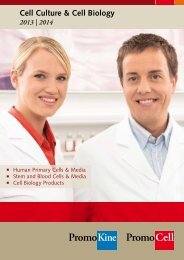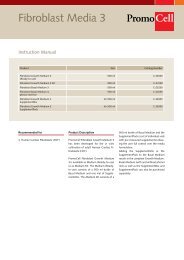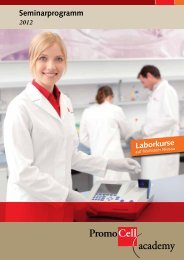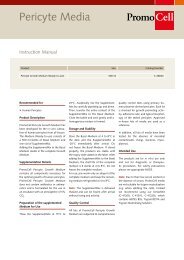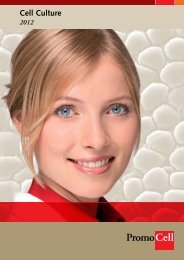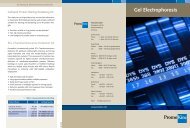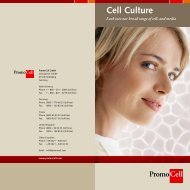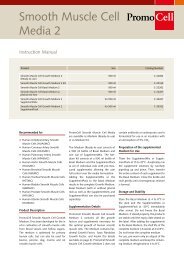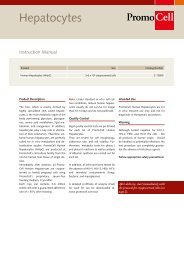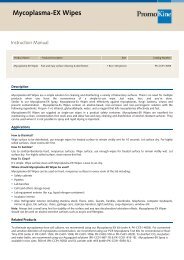Chondrogenic Differentiation and Analysis of MSC - PromoCell
Chondrogenic Differentiation and Analysis of MSC - PromoCell
Chondrogenic Differentiation and Analysis of MSC - PromoCell
You also want an ePaper? Increase the reach of your titles
YUMPU automatically turns print PDFs into web optimized ePapers that Google loves.
<strong>Chondrogenic</strong> <strong>Differentiation</strong><br />
<strong>and</strong> <strong>Analysis</strong> <strong>of</strong> <strong>MSC</strong><br />
Application Note<br />
Background<br />
Mesenchymal Stem Cells (<strong>MSC</strong>) are<br />
fibroblastoid multipotent adult stem cells<br />
with a high capacity for self-renewal. So<br />
far, these cells have been isolated from<br />
several human tissues, e.g. bone marrow,<br />
adipose tissue, umbilical cord matrix, ten-<br />
don, lung, <strong>and</strong> the periosteum [1].<br />
Recently it was shown that <strong>MSC</strong> recruit<br />
from the perivascular niche which rep-<br />
resents a tight network throughout the<br />
vasculature <strong>of</strong> the whole body. These<br />
perivascular cells lack endothelial/he-<br />
matopoietic markers (CD31, CD34) but<br />
express CD146, PDGF-R beta, <strong>and</strong> alka-<br />
line Phosphatase [2].<br />
Characterization<br />
<strong>MSC</strong> show a CD10 + , CD13 + , CD44 + ,<br />
CD73 + , CD105 + phenotype, but do not<br />
express CD31 or CD45 [1]. In addition<br />
to surface marker analysis, the most<br />
common <strong>and</strong> reliable way to identify a<br />
population <strong>of</strong> <strong>MSC</strong> is to verify their mul-<br />
tipotency. <strong>MSC</strong> can be differentiated in<br />
adipocytes, osteoblasts, myocytes, <strong>and</strong><br />
chondrocytes in vivo <strong>and</strong> in vitro [1,3].<br />
In addition, trans-differentiation <strong>of</strong> <strong>MSC</strong><br />
into cells <strong>of</strong> non-mesenchymal origin, e.g.<br />
hepatocytes, neurons <strong>and</strong> pancreatic islet<br />
cells, has been observed in vitro when<br />
specific culture conditions <strong>and</strong> stimuli<br />
apply [1].<br />
The directed differentiation <strong>of</strong> <strong>MSC</strong> is<br />
carried out in vitro using the appropriate<br />
differentiation media, e.g. the ready to<br />
use <strong>PromoCell</strong> <strong>MSC</strong> <strong>Differentiation</strong> Me-<br />
dia (see below for differentiation proto-<br />
cols). These terminally differentiated cells<br />
are histochemically stained to determine<br />
their specific marker pr<strong>of</strong>ile (see below<br />
for staining protocol).
2<br />
Application Note - <strong>Chondrogenic</strong> <strong>Differentiation</strong> <strong>and</strong> <strong>Analysis</strong> <strong>of</strong> <strong>MSC</strong><br />
Use aseptic techniques <strong>and</strong> a laminar flow bench.<br />
<strong>Chondrogenic</strong> <strong>Differentiation</strong><br />
1. Seed Mesenchymal Stem Cells<br />
Plate 1 x 10 5 <strong>MSC</strong> per well <strong>of</strong> a 96-well U-bottom suspension culture plate using<br />
<strong>MSC</strong> Growth Medium. Work in duplicate.<br />
2. <strong>MSC</strong>-spheroid formation<br />
Spheroids will spontaneously form within 24 - 48 hours.<br />
Note: The more cells you use, the bigger the spheroids. You may use up to 3 x 105 cells per well.<br />
3. Induce <strong>MSC</strong>-spheroids<br />
Induce one <strong>of</strong> the duplicate samples with <strong>MSC</strong> <strong>Chondrogenic</strong> <strong>Differentiation</strong><br />
Medium. Use <strong>MSC</strong> Growth Medium for the remaining well as a negative control.<br />
4. Differentiate induced <strong>MSC</strong>-spheroids<br />
Incubate for 21 days. Change Medium every third day. Be careful not to aspirate<br />
the spheroids.<br />
<strong>Chondrogenic</strong><br />
<strong>Differentiation</strong>
Important: Do not let the cells dry for longer than 30 sec.<br />
throughout the entire staining procedure!<br />
Detection <strong>of</strong> cartilage extracellular matrix<br />
<strong>Chondrogenic</strong> differentiation <strong>of</strong> <strong>MSC</strong> in 3D spheroid culture results in formation <strong>of</strong><br />
cartilage with a typical extracellular matrix. A key molecule - besides collagen type II<br />
within this extracellular matrix is the proteoglycan aggrecan. Aggrecan can be used as<br />
an indicator for cartilage formation <strong>and</strong> can be detected with Alcian Blue, a dark-blue<br />
copper-containing dye.<br />
1. Prepare solutions <strong>and</strong> buffers<br />
Mix 60 ml Ethanol (98 - 100%) with 40 ml Acetic Acid (98 - 100%). Dissolve<br />
10 mg Alcian Blue 8 GX in this solution to achieve the Alcian Staining Solution. The<br />
solution is stable for one year.<br />
Mix 120 ml Ethanol (98 - 100%) with 80 ml Acetic Acid (98 - 100%) to get the<br />
Destaining Solution.<br />
2. Wash the cartilage spheroids<br />
Take the cartilage spheroids from the incubator <strong>and</strong> carefully aspirate the medium.<br />
Carefully wash the spheroids twice with Dulbecco’s PBS, w/o Ca ++ / Mg ++ (Cat. No.<br />
C-40232).<br />
Note: Do not aspirate the spheroids!<br />
4. Fixation <strong>of</strong> the cartilage spheroids<br />
Carefully aspirate the PBS <strong>and</strong> transfer the tissue culture dish to a fume hood.<br />
Add enough neutral buffered formalin (10%) to cover the cartilage spheroids.<br />
Incubate at room temperature for 60 min.<br />
4. Wash the cartilage spheroids<br />
Carefully aspirate the formalin <strong>and</strong> wash the spheroids twice with distilled water.<br />
Note: Do not aspirate the spheroids!<br />
5. Stain the cells<br />
Carefully aspirate the distilled water <strong>and</strong> add enough Alcian Staining Solution to<br />
generously cover the cartilage spheroids, as some evaporation will occur. Incubate<br />
overnight at room temperature in the dark.<br />
6. Wash the cells<br />
Carefully aspirate the Alcian Staining Solution <strong>and</strong> wash the cartilage spheroids with<br />
the Destaining Solution for 20 min. Repeat the wash step twice. Carefully aspirate<br />
the Destaining Solution <strong>and</strong> add PBS.<br />
Note: Cartilage will retain an intense dark-blue stain during the destaining procedure,<br />
whereas other tissue will loose the blue color almost completely.<br />
7. Analyze the cartilage spheroids<br />
Cartilage is intense dark-blue, whereas other tissue is at most faintly bluish.<br />
1)<br />
2)<br />
Please follow the recommended safety precautions for the chemicals used in this<br />
procedure!<br />
Application Note - <strong>Chondrogenic</strong> <strong>Differentiation</strong> <strong>and</strong> <strong>Analysis</strong> <strong>of</strong> <strong>MSC</strong> 3<br />
Fig. 1: h<strong>MSC</strong>-BM spheroids after in vitro differentiation<br />
into cartilage using <strong>PromoCell</strong> Mesenchymal Stem<br />
Cell <strong>Chondrogenic</strong> <strong>Differentiation</strong> Medium (Alcian blue<br />
staining). The induced spheroid exhibits a strong blue<br />
staining for cartilage extracellular matrix (1). The control<br />
spheroid cultured in Mesenchymal Stem Cell Growth<br />
Medium is almost colorless (2).<br />
Detection<br />
<strong>of</strong> cartilage<br />
extracellular<br />
matrix
References<br />
[1] da Silva Meirelles L, Caplan AI, Nardi NB., Stem Cells 2008; 26(9):2287-99.<br />
[2] Crisan M, Yap S, Casteilla L, et al., Cell Stem Cell 2008; 3(3):301-13.<br />
[3] Caplan AI. Cell Stem Cell 2008, 3(3):229-30.<br />
Related Products<br />
Product Size Catalog Number<br />
Human Mesenchymal Stem Cells<br />
from Bone Marrow (h<strong>MSC</strong>-BM)<br />
Human Mesenchymal Stem Cells<br />
from Umbilical Cord Matrix (h<strong>MSC</strong>-UC)<br />
Human Mesenchymal Stem Cells<br />
from Adipose Tissue (h<strong>MSC</strong>-AT)<br />
Mesenchymal Stem Cell Growth Medium<br />
(Ready-to-use)<br />
Mesenchymal Stem Cell Adipogenic<br />
<strong>Differentiation</strong> Medium (Ready-to-use)<br />
Mesenchymal Stem Cell <strong>Chondrogenic</strong><br />
<strong>Differentiation</strong> Medium (Ready-to-use)<br />
Mesenchymal Stem Cell <strong>Chondrogenic</strong><br />
<strong>Differentiation</strong> Medium w/o Inducers<br />
(Ready-to-use)<br />
Mesenchymal Stem Cell Osteogenic<br />
<strong>Differentiation</strong> Medium (Ready-to-use)<br />
Mesenchymal Stem Cell Neurogenic<br />
<strong>Differentiation</strong> Medium (Ready-to-use)<br />
<strong>PromoCell</strong> GmbH<br />
Sickingenstr. 63/65<br />
69126 Heidelberg<br />
Germany<br />
Email: info@promocell.com<br />
www.promocell.com<br />
500,000 cryopreserved cells<br />
500,000 proliferating cells<br />
500,000 cryopreserved cells<br />
500,000 proliferating cells<br />
500,000 cryopreserved cells<br />
500,000 proliferating cells<br />
<strong>MSC</strong>-Qualified Fetal Calf Serum 100 ml<br />
500 ml<br />
DetachKit 30 ml<br />
125 ml<br />
250 ml<br />
Cryo-SFM 30 ml<br />
125 ml<br />
North America<br />
Phone: 1 – 866 – 251 – 2860 (toll free)<br />
Fax: 1 – 866 – 827 – 9219 (toll free)<br />
Deutschl<strong>and</strong><br />
Telefon: 0800 – 776 66 23 (gebührenfrei)<br />
Fax:<br />
France<br />
0800 – 100 83 06 (gebührenfrei)<br />
Téléphone: 0800 90 93 32 (ligne verte)<br />
Téléfax: 0800 90 27 36 (ligne verte)<br />
United Kingdom<br />
Phone: 0800 – 96 03 33 (toll free)<br />
Fax: 0800 – 169 85 54 (toll free)<br />
Other Countries<br />
Phone: +49 6221 – 649 34 0<br />
Fax: +49 6221 – 649 34 40<br />
C-12974<br />
C-12975<br />
C-12971<br />
C-12972<br />
C-12977<br />
C-12978<br />
500 ml C-28010<br />
100 ml C-28011<br />
100 ml C-28012<br />
100 ml C-28014<br />
100 ml C-28013<br />
100 ml C-28015<br />
C-37386<br />
C-37385<br />
C-41200<br />
C-41210<br />
C-41220<br />
C-29910<br />
C-29912<br />
Dulbecco’s PBS, w/o Ca ++ / Mg ++ 500 ml C-40232<br />
h<strong>MSC</strong>-BM Pellet > 1 million cells per pellet C-14090<br />
h<strong>MSC</strong>-UC Pellet > 1 million cells per pellet C-14091<br />
h<strong>MSC</strong>-AT Pellet > 1 million cells per pellet C-14092



